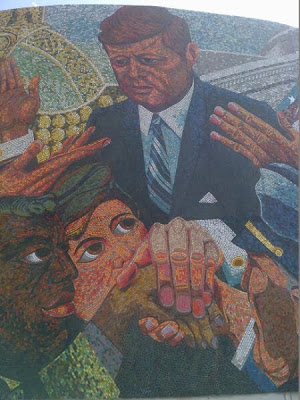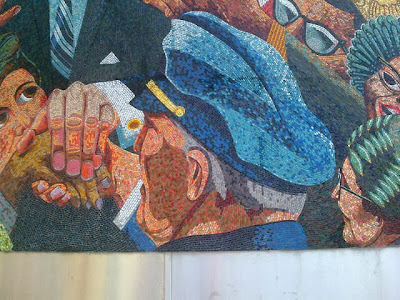I was astonished to realise that I've been sitting on the pictures here, with a view to working them up into a blog post, since I last wandered round Digbeth on a July Sunday morning. The story of this mosaic is such a Birmingham thing, it has to get a Hedge-spirit post all on its own. I have commented before that the spirit of Birmingham is one of busyness: Birmingham is a city that has real trouble leaving anything alone for long, & this is particularly true of the redevelopment of the city centre in the 1960s. A major mistake in the planning of the time was in the construction of the Inner Ring Road, for which loads of historic buildings were bulldozed. The road became known as the 'concrete collar', a collar which was far too tight as it effectually completely stifled further development of the city centre, & the years since its construction have been spent in its undoing. There is a salutary history lesson here: the council is free to reredevelop the Inner Ring Road because it is a currently unloved 1960s eyesore, so it is actually fortuitous that it was developed when it was. Had the historic buildings which were demolished to make way for it been left, they may well have attracted listing & would have stifled redevelopment in the exact line of the concrete collar round the city. This is merely my opinion, an awful lot of people on historic Birmingham forums would disagree, & the flip side of this coin is that without the Inner Ring Road development the city centre would look radically different; a lot of pre-1960s photos of the city centre are unrecognisable from today.
One of the signature elements of the Ring Road development was that the roads were interspersed with little garden areas. I think the only one surviving now is the one at the bottom of Smallbrook Queensway with a pagoda in it. If you literally go under the road there you get a feeling of what Birmingham felt like from the 1960s, up until rereconstruction started in the 1990s, complete with underpasses, public mural art, some very dodgy dark corners & a smell of stale urine. I recently went through it instead of using the pedestrian crossings as I normally would, & realised I had forgotten what these areas felt like. I think the most ridiculous one was Manzoni Gardens, which was an attempt to create a garden area on the site of the old indoor market, which had stood derelict for years, near New Street Station. It's the words 'near New Street Station' that make it ridiculous, & in fact it shared the major failing of the 1960s Bull Ring, of being surrounded by ring roads & completely unrestful. Ironically it is named after Herbert Manzoni, who as city engineer & surveyor presided over the radical changes in the city, & whose attitude was:
'I have never been very certain as to the value of tangible links with the past. They are often more sentimental than valuable... As to Birmingham�s buildings, there is little of real worth in our architecture. Its replacement should be an improvement... As for future generations, I think they will be better occupied in applying their thoughts and energies to forging ahead, rather than looking backward.' (http://en.m.wikipedia.org/wiki/Herbert_Manzoni)
Of course the irony is that his preferred policy is now regretted & his concrete (literally) legacy to a great extent despised if not demolished. I have unfortunately been unable to find the source of the famous comment that he caused more damage to the city than the luftwaffe. Even the Hound feels free to refer to the gardens named after him as ridiculous: by the time I knew them they were a wilderness of broken benches; it felt like sitting on a traffic island. A further sense of ridiculousness is added by the fact that it was here the famous King Kong statue stood in the 1970s. From a Witch point of view the important point here is that this historical toing & froing is that this reflects the spirit of the place: the only moral would be that each generation is setting itself up for a fall if it thinks it has reached a definitive solution to human life's recurrent problems.
Another of these 'gardens' in the space inside a traffic island was Kennedy Gardens, the original site of the mosaic that is the subject (or pretext) of this post. It is no longer there, & in some circles is better remembered for different reasons than the Kennedy memorial (you didn't think this would be a *sensible* or *vanilla* post on an area of Brum, did you?):
'Large traffic island situated at the northern end of central Birmingham adjacent to Snow Hill Station and St Chads Cathedral. The site was home to the Kennedy Gardens cottage, which was so infamous it was listed in the world wide Spartacus Guide. [...] The public toilet was closed in the late 1980s and the traffic island and gardens were demolished to make way for a new office, hotel and residential development in 2007.' (http://www.gaybirminghamremembered.co.uk/topics/Kennedy%20Gardens)
The cottage was not only world famous, it was the scene for the beginning of the downfall of 1970s sex symbol, actor Peter Wyngarde:
'In 1975, he was arrested, convicted and fined �75 for an act of "gross indecency" in the toilets of Gloucester Bus Station,[6] which followed an arrest and caution for similar activities in the toilets at Kennedy Gardens in Birmingham the previous year. After the first incident, Wyngarde was interviewed for the News of the World and the Birmingham-based Sunday Mercury, and asserted that the arrest was due to a misunderstanding; in his defence after the second incident he claimed he had suffered a "mental aberration".' (http://en.m.wikipedia.org/wiki/Peter_Wyngarde)
Kennedy Gardens are depicted facing away from the Kennedy Mosaic in the first picture, which truly shows how bleak & dispiriting these places were. The second picture shows the mural in its original situation. It was unveiled after a fundraising effort by Birmingham's Irish community, & the artist was Kenneth Budd. Budd's other works for Birmingham in the 1960s include work at Old Square, Holloway Head, & Colmore Circus: the only one I know to be still standing in its original form is the Holloway Head one, in the traffic island I mention above. Of course with the repeated recreation of the city centre, some of Budd's work met the same fate as these engineered 'gardens', & the Kennedy mosaic was demolished in 2007, parts of it, notably heads, being retained in storage.
'In 2012 it was re-created using new materials. The new mosaic was erected in January 2013, in the city's Irish Quarter, on Floodgate Street in Digbeth, in reworked form, including the controversial addition of a new face, that of former Lord Mayor of Birmingham Mike Nangle, the city's first Irish Lord Mayor. The work was overseen by Budd's son, Oliver, who worked from his father's original drawings. The retained sections were not used as the colours had faded and would not match the new Smalti mosiac tiles. A formal unveiling took place on 23 February 2013.' (http://en.m.wikipedia.org/wiki/J._F._Kennedy_Memorial,_Birmingham)
Personally I much prefer the recreated mosaic. It was in a depressing place before, the colours are brighter now, faces leap out at you as personalities & with a camera you can zoom in enough to see the detail of the tiles. I love it now, it never really made an impact on me before. The remaining photos of the mosaic are ones I took in July of details from it. I note that it has been surrounded by a storm of controversy since being unveiled, but that's the point. To end where I started, the Birmingham 'thing' is an inability to leave anything alone!
------------------






